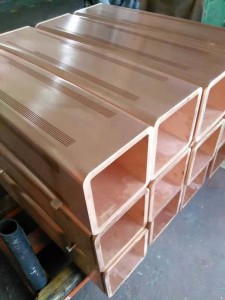Copper Mould Tube Curvature: Core Roles in Steel Making (Part 1)

In continuous casting (the main way to shape molten steel into billets or slabs), copper mould tubes have a gentle inward curve. This curve is engineered to match molten steel’s shrinkage as it cools and solidifies, directly affecting steel quality, production efficiency, and equipment reliability. Below are its two key functions.
1. Compensates for Steel Shrinkage to Ensure Uniform Heat Transfer
Molten steel shrinks when solidifying (high-carbon steels shrink more than low-carbon ones). A straight tube would leave gaps between the solidified billet and tube wall—gaps slow heat transfer (air is a poor conductor), causing:
- Surface cracks: Uneven solidification creates weak spots;
- Internal unevenness: Slow cooling concentrates elements (e.g., carbon) in the billet’s core, reducing strength consistency.
The tube’s “wider top, narrower bottom” curve closes these gaps, keeping the billet tight against the tube. This ensures steady heat transfer, cutting surface cracks and internal defects.
Operator Tip: Switching steel grades? Recalibrate the curve first—small deviations raise crack risk by 20%+. Document adjustments for quality audits (e.g., ISO 9001).
2. Regulates Friction for Smooth Billet Extraction
After solidification, billets are pulled out of the mold at a steady speed. The curve controls friction between billet and tube—too much or too little causes issues:
- Excessive curvature: A too-narrow tube bottom squeezes the billet, increasing pull resistance. This scratches the billet or causes jamming (costly downtime, often thousands per hour).
- Insufficient curvature: Gaps let the billet shift, leading to misshapen billets/slabs. Air in gaps also forms surface scale (rust), requiring extra processing.
A well-tuned curve keeps contact “gap-free but non-interfering”, minimizing jams (<0.1% of casts) and maintaining 99.5%+ dimensional accuracy.
Troubleshooting Tip: For intermittent jams, check the curve at top (100mm below inlet), midpoint, and bottom (100mm above outlet). Usually only the midpoint is off—replace that segment to avoid long shutdowns.
What’s Next?
These functions are foundational, but the curve also extends tube life by reducing stress wear and works with mold “taper” to stabilize production. We’ll cover these in Part 2.
Post time: Aug-19-2025